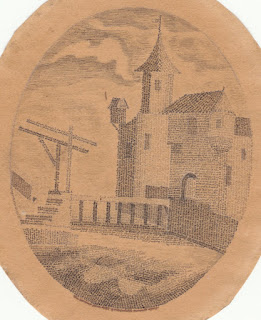There were a number of images of the Somerton Man distributed after his death, in fact, to be more precise, the pictures were taken after his autopsy.
In this post the focus is on the official image distributed by SA Police at the time. I am putting the following images forward for everyone's consideration and review. I will start by saying that there is something amiss with this Police image:
At this point if you could take a close look at the profile in the headline and then let's move on to this next shot.
This image simply corrects the positioning so that we are now seeing a vertical version plus, I have increased the size of the image so that we can see the individual pixels. Look more carefully now at the side of the cheek between the lower lobe of the ear and a mid point on the chin, you should see an almost straight line that connects the two points, we will see more of that shortly.
In this next image I have marked up the areas of interest and they show a number of points worth considering.
Firstly, and with apologies for the gory aspects, the circled area at the hairline shows where the skull cap has slipped back after the autopsy.
Next there are a series of X's that commence from just beneath the circle and then progress down past the front of the ear and then in an almost straight line along the jaw to a point central to the chin. just join the X's to see what I mean.
Now here's a comparison image showing the marked and unmarked versions alongside each other:
The idea here is to illustrate clearly how the line appears on the forehead and then progresses down to the ear, across the front of the ear and then directly down to the centre of the chin.
Notice also that the neck and forehead show wrinkles and signs of age but both stop abruptly at the line highlighted. This suggests to me that this image has been altered and that it is quite possible that what we see here is a young face superimposed on an older head.
I must stress that I have not interfered with or altered this image in any way apart from increasing it's size.So, how could this have been done given that in the 1940's the smart tools and software we have today did not exist? A simple answer is that skilled photographers could create a 'Montage' by cropping images and then manipulating the cropped parts to achieve the desired results.
Below is how this 'montage' effect can be achieved today.
In this image I have cropped the area that has been outlined so that only that area is visible.
As you can see it's a much smaller image of the Somerton Man's face and again in my view it seems to show quite a 'young' looking face.
Next, here's a head shot of a man taken in the 1930's, this man has nothing to do with the case as far as I know.
What we will do now is to 'superimpose' the Somerton Man's face shown above onto this man's head structure.
To do this I used Gimp and some simple tools that it has including, 'move', 'rotate' and 'smudge'.
Here's the resultant 'superimposed' image, I have deliberately left the original texture and shading on the Somerton Man face portion as this is purely example image.
It is quite possible to match the colours and shades and then blend the two images together.
Is it possible that the lines we can see were caused by the application of Morticians wax, a common practice to improve the appearance of a corpse/ If that were the case, why did it stop in a straight line, from what i understand such 'wax' was applied much like make up and was meant to provide a smooth all round finish.
The question is clear, is the image of the Somerton Man as distributed by the SA Police in 1948 a genuine untouched image or was it altered by using the 'Montage' effect and a younger face included that replaced the real facial image of the Somerton Man? If that were to be the case it would certainly help to explain why nobody has been able to identify him in the 64 years since his death.
Another major aspect of the case to be questioned and yet another reason for the exhumation of his remains.
Please take the time and sign up to the petition calling for that to occur right here:










































